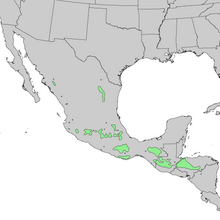| Pinus pseudostrobus | |
|---|---|

| |
| var. apulcensis in cultivation | |
| Conservation status | |
 Least Concern (IUCN 3.1) | |
| Scientific classification | |
| Kingdom: | Plantae |
| Clade: | Tracheophytes |
| Clade: | Gymnospermae |
| Division: | Pinophyta |
| Class: | Pinopsida |
| Order: | Pinales |
| Family: | Pinaceae |
| Genus: | Pinus |
| Subgenus: | P. subg. Pinus |
| Section: | P. sect. Trifoliae |
| Subsection: | P. subsect. Ponderosae |
| Species: | P. pseudostrobus |
| Binomial name | |
| Pinus pseudostrobus Lindl. | |

| |
| Natural range of Pinus pseudostrobus. Pinus pseudostrobus is also found in El Salvador. | |
| Synonyms | |
|
Pinus angulata Roezl Pinus alpucensis Lindl. Pinus astecaensis Roezl ex Gordon Pinus coatepecensis (Martínez)Gaussen Pinus estevezii (Martínez) J.P.Perry Pinus heteromorpha Roezl Pinus nubicola J.P.Perry Pinus oaxana Mirov Pinus orizabae Gordon Pinus prasina Roezl Pinus protuberans Roezl Pinus regeliana Roezl | |
Pinus pseudostrobus, known in English as the smooth-bark Mexican pine and in Spanish as chamite or pacingo, is a tree found in forests of Mexico and Central America. It is 8 to 25 m tall with a dense and round top.It is threatened by logging and wood harvesting. The bark is brown and fissured and smooth when young. It is subject to ex situ conservation. It grows at altitudes between 850 and 3250 m. from 26° to 15° north latitude, from Sinaloa, Mexico to Nicaragua and Honduras. It occurs within a rainfall regime that rains mostly in summer.
In some forested areas like southern Nuevo León Pinus pseudostrobus is the tree with largest volume per hectare.
English botanist John Lindley described the species in 1839. It is divided into Pinus pseudostrobus var.apulcensis (Lindl.)Shaw (Apulco pine), Pinus pseudostrobus f.protuberans Martínez and Pinus pseudostrobus var.pseudostrobus.
It has been introduced in New Zealand near sea level and has done well.
-
 Male cones at San Francisco Botanical Garden
Male cones at San Francisco Botanical Garden
-
 Pinus pseudostrobus, Cerro Pelón, Mexico
Pinus pseudostrobus, Cerro Pelón, Mexico
References
- ^ Farjon, A. (2013). "Pinus pseudostrobus". IUCN Red List of Threatened Species. 2013: e.T42404A2977667. doi:10.2305/IUCN.UK.2013-1.RLTS.T42404A2977667.en. Retrieved 16 November 2021.
- ^ "Pinus pseudostrobus". Plants of the World Online. Retrieved 31 March 2021.
- ^ "Pinus pseudostrobus var.pseudostrobus". Plants of the World Online. Retrieved 2 April 2021.
- ^ "Pinus pseudostrobus var.apulcensis". Plants of the World Online. Retrieved 2 April 2021.
- "Pinus pseudostrobus f.protuberans". Plants of the World Online. Retrieved 4 April 2021.
- ^ "Pinus pseudostrobus". iNaturalist. Retrieved 31 March 2021.
- Bautista Cruz, Angelina; González Cubas, Rigoberto; Treviño Garza, Eduardo Javier; Yerena Yamallel, José Israe; Rodríguez, Eduardo Alanís; Aguirre Calderón, Oscar Alberto (2022). "Modelación de la biomasa aérea en bosques templados subtropicales secos en el noreste de México" [Modeling of aerial biomass in dry subtropical temperate forests in northeastern Mexico]. Bosque (in Spanish). 43 (3). doi:10.4067/S0717-92002022000300243.
This conifer-related article is a stub. You can help Misplaced Pages by expanding it. |
- IUCN Red List least concern species
- Pinus
- Trees of Northern America
- Garden plants of North America
- Ornamental trees
- Trees of temperate climates
- Least concern plants
- Flora of the Sierra Madre Occidental
- Flora of the Sierra Madre Oriental
- Flora of Central Mexico
- Flora of the Trans-Mexican Volcanic Belt
- Flora of the Chiapas Highlands
- Conifer stubs